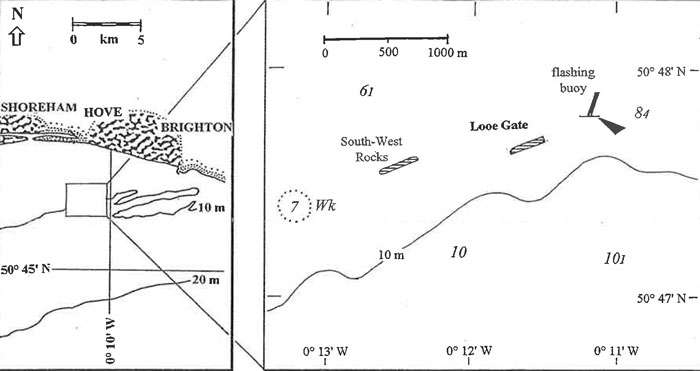SUSSEX MARINE SITES OF NATURE CONSERVATION IMPORTANCE
| Site: Looe Gate | Ref. No. 10 | ||||||
| Location: 4 km SSW of Hove | Other conservation designation?: No |
||||||
| Lat./Long. position of centre of site: 50° 47' 74" N 0° 11' 59" W |
OS grid ref. of centre of site: TQ 273 009 |
Author: Robert Irving |
|||||
| Sea bed type: Chalk cliff, silty sand mixed with shells. |
Depth range (below chart datum): 6-9 m |
Date identified: November 1995 |
|||||
Summary
The feature known as Looe Gate (reasons for name unknown, though a hole in the cliff has been reported at one point) is a low-lying chalk cliff, mostly 0.5 m in height but reaching a maximum height of 1.5 m in places. The length of exposed chalk is approximately 220 m. Its width can vary with shifting overlying sand, but may reach up to 5 m. The surrounding sea bed is of silty sand with shell debris. The northward-facing cliff face varies in profile from a vertical face with an undercut base, through a low series of terraces, angled faces, smooth slope to jumbled chalk boulders and broken bedrock (Wood 1992).
Biological Description
The uppermost (shallowest) parts of the cliff support a sparse foliose red algal turf. Surveys in 1986 and 1994 revealed the attached fauna to be varied and densely packed, except on broken surfaces. Dominant elements of the cover were sponges and bryozoans. Eleven species of sponges were recorded in 1986, the most common being Cliona celata (the boring form), Esperiopsis fucorum and Dysidea fragilis (Wood 1992). The bryozoans Flustra foliacea, Cellepora pumicosa and Bugula spp. are frequently recorded. Anthozoans represented include the anemone Sagartia troglodytes and the soft coral Alcyonium digitatum. The tubicolous worm Sabellaria spinulosa is known to occur here, as is the 'feather duster' worm Bispira volutacornis. Two species of piddock are present: the common piddock Pholas dactylus, which tends to prefer boring vertically into horizontal bedrock, and the smaller 'red nose' Hiatella arctica, which favours boring horizontally. Amongst the smaller sessile groups, sea squirts were particularly varied in 1986, with 12 species being recorded, seven of which were common. These included Aplidium punctum, Morchellium argus, Pyvnoclavella aurilucens, Ascidiella scabra and Molgula manhattensis. A variety of fishes have been recorded from this site, with bib Trisopterus luscus and poor cod Trisopterus minutus being common, and goldsinny Ctenolabrus rupestris and corkwing wrasse Ctenolabrus melops also being present.
The sea bed on the north (lower) side of the reef is of mixed sediment: chalk pebbles, gravel, sand, shell debris and occasional small chalk boulders. Occasional sparse red algae can be found attached to cobbles and small boulders. Otherwise, the fauna is typical of this type of sea bed, with the anemones Urticina felina and Cerianthus lloydii, the crabs Necora puber and Cancer pagurus, the hermit crab Pagurus bernhardus, the topshell Calliostoma zizyphinum and occasional chains of slipper limpets Crepidula fornicata.
References:Irving, R. A. . Report of the West Sussex Seasearch Project, 1994: Littlehampton to Brighton Unpublished Report, Coldwaltham, West Sussex |
|||||||
| Sussex SEASEARCH dive nos.: 94/35&36, 46-48 | |||||||
| SEMCS Chalk Cliffs Project, site log nos.:52 & 55 | |||||||
Site Location

Diagrammatic representation of site: Looe Gate


:Link to this page
Copyright Sussex Biodiversity Records Centre © 2025